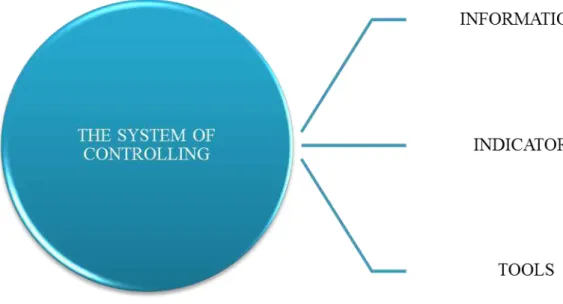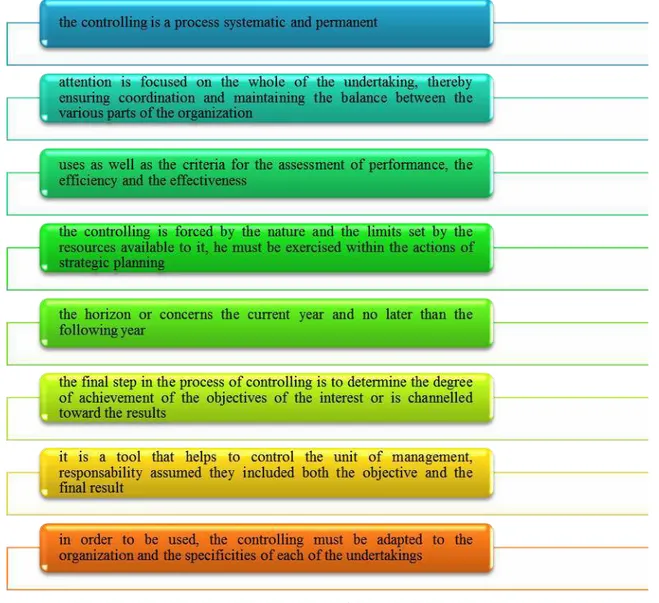STRUCTURAL APPROACH TO THE CONTROLLING
LOREDANA CIURL
Ă
U
LECTURER PH.D, FACULTY OF ECONOMICS,
“CONSTANTIN BRÂNCU
Ş
I” UNIVERSITY FROM TÂRGU JIU,
e-mail: lciurlau@yahoo.com
Abstract
Economic concentration has led to the emergence of large enterprises and complex that by the activities or the environment of their operation because of an activity of decentralization. The enterprise is cut in centers of responsibility which enjoys a autonomy more or less widely. The management control will be able to meet the needs of coordination of these organizations decentralised, orienting the "actors" within the meaning of the desired by the manager through the evaluation of the results obtained. The success of an enterprise requires a continuous adapting it to the environment or and competitiveness is transformed into a economic criterion by excellence.
Key words: controlling, performance, organization
JEL Classification: M40, M41
1.Introduction
The management control has occurred since the beginning of the last century in a few industrial enterprises in the USA and has seen a significant development in the framework of the French undertakings at the beginning of the years '70.
F.M. Taylor has been one of the initiators of the industrial management, inserting that instruments: analytical accounts, the timer time at the direct labor and finally, generated and entered the standards as instruments to measure the performance.
In the second half of the century the XX century there have been many significant changes in the framework of the economic environment. These changes are produced in the undertakings of a large number of internal changes between them being customer orientation, technological development and innovation, the role of the part of the leadership of the strategic, concentrations on the quality of the role of human resources in the company, the management of the information.
In the vision of Garcia L., the management control is first of all a method, a medium to drive in a specific order thinking and activity, the first being forecast for the fixing of a prognosis on the goals and then to carry out the action program. Secondly, the management control refers to the deviations, comparing the achievements with forecasts and, at the same time, noting the existing differences between the two sets of data.
During the past two decades, the management control has been subjected to metamorfozarilor more than in any other period in its history. These changes relate to the forms in a more advanced stage of the production technologies, at the evolution of the fast and unpredictable demand, to the phenomena of globalization and international competitiveness and, why not, at an attitude of more receptive stage of Western organizations on systems management foreign matter. The management control is the product of the history of certain forces that cannot be ignored in the process of creating, deployment and use of new techniques and tools.
The adoption of the systems of modern control the management has an effect on a large scale at the level of all the structures of the organization. All the organizations shall develop in time certain specific characteristics, which become an essential condition of their operation. The implementation of new control systems management, considered by the otherwise necessary, may not exceed the difficulties caused by the reactions of the aspects of the human factor and the type of crop specific. These difficulties are fundamental factors which may cause the failure or success deployment no matter from the advantages offered by the new system.
2. The system of controlling
instrument panels (figure no. 1).
Figure no. 1 "Components of the controlling"
Through a system of information provided by the controlling, managers can take decisions to the current management which allow the orientation of the behaviors for the purposes of the completion of the strategic objectives of the company. In other words, under practically the management control provides a equipment for the control of how operational staff and the persons responsible for the management committee shall meet the objectives in the short term, taking into account the strategic guidelines. For an organization economic, overall performance and, implicitly, the quality of the management is measured in terms of profitability and liquidity, performance as defined in the context of sustainable development of the undertaking which take into account the environmental restrictions socio-economic and natural. The sustainable development of the undertaking involves obtaining the informations.
The controlling uses instruments; these covers indicators that are based on the enterprise's information system (Albu N., Albu C., 2003).
The role of the informations
Must be ensured the consistency and reliability of the information system, because quality information constitutes a factor of competitiveness for enterprise. Of these considerations, the information system shall be subject to periodic control of the usefulness, efficacy and the cost or analysing the qualitative attributes as well as the rapidity, accuracy, clarity and the ability to translate the reality.
The role of the indicators
The information flows using specific supports and under various forms, the data being compiled in the areas of significance, in the indicators. From the point of view of these indicators is difficult because a suitable balance must be struck between too much and too little information about. Watch the indicators must be clear relevant,, constant, reliable and loyal. They also must follow all aspects of the activity of the undertaking.
The role of the instruments of management
Tracking of indicators on certain periods of time shall be carried out by grouping them in management tools.
Instrument shall mean, within the meaning of normal, a unit used to execute a work; for the management control, but he represents a "Middle" in evolution.
3. The connection of the controlling to other forms of internal control
A system of control the management does not work in mechanically. The quality of its depends to a large extent on the intention of implies the scientists from different hierarchical levels and from various services. And this can be stimulated by the establishment of a system for performance evaluation associated with more or less direct a system of rewards.
The particular activity of the control of the management derives from its characteristics, which may be listed in such[Aslau T., 2001]:
Figure no. 2 "Characteristics of the controlling"
The interaction of the controlling with the strategic and the execution(operational), arising out of the role of the relatively on which they have in the process of driving and of the specificity of each of these subsystems.
The center position of the control of the management in relation to the strategic control and the execution can be easily observed whether analyzes, in short, the relationship that exists between these forms of internal control of the company.
Figure no. 3 "Forms of the internal control"
The connection between the three levels of control is a key element of an effective control. The role of the controlling is to ensure the consistency of the strategy with execution. The control process is closely related to the level of the decision:
Figure no. 4,,Level decision-process of the control"
Any controlling system is closely associated with a system for measuring performance.
Actually, it is a process that allows you to perform a convergence of the aims of the individual and of the consistency with the overall objectives of the organization. This convergence of purpose is an essential condition for carrying out a process of controlling.
The main challenges of the controlling can be formalized as follows: which is the strategic objective of the organization?
what types of resources requires the organization and where the expected to get them in the short term and the long-term?
4. Conclusions
The controlling in the process of rolling code, represents a reaction to the organizational changes. Its potential will not be shown only after the system will be understood, accepted and used by all the structures of the organization. The role of the controlling in this context will be one of the development of mechanisms which may be useful managerial team, beyond the perspectives, usually limited, criteria of the accounting officer.
As a conclusion, the controlling is a process that serves to the orientation of the management by the objectives of the organization and a tool for the assessment of the performance thereof. This should be taken of the following points:
the controlling is an environment for the transmission of the strategy in all the organizations;
the question of the controlling consists in the design of the mechanisms that allow individual behavior to coincide with the price asked by the organization to think of what is global when operating in local plan;
the controlling of developing activities of planning, checking and fault finding, for which the administrative rules which correspond to the local correspond with drawn by the organization, with a final;
the controlling is an environment of mobilization of talent and energy by the collective success of the objectives of the organization;
the controlling is a process of managing behaviors.
5.Bibliography:
[1] Albu C., Albu A., „Instrumente de management a performanţei”, Editura Economică, Bucureşti, 2003; [2] Albu C., Albu A., Feleagă L., Contabilitate, control şi guvernanţă, Editura Economică, Bucureşti, 2012; [3] Aslău T., Controlul de gestiune dincolo de aparenţe, Editura Economică, Bucureşti, 2001;
[4] Cîndea M., contabilitate de gestiune şi control de gestiune, Editura Tehnopress, Iaşi, 2011;
[5] Dumitrana M., Caraiani C., Dascălu C...., Control de gestiune, Editura Universitară, Bucureşti, 2010; [6] Guinea F.A., Creativitate versus fraudă în controlul de gestiune, Editura ASE, Bucureşti, 2010; [7] Sgârdea F.M., Control de gestiune, Editura ASE, Bucureşti, 2009.


